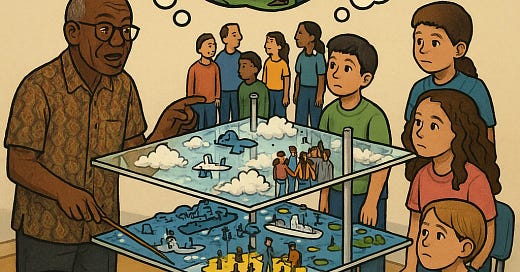033: The World Peace Game: A Creative Resistance Against Despair
How a creative classroom game equips children to tackle global conflicts with collaboration and empathy.
Art as Resistance
Art, storytelling, and conversations about peace can serve as profound acts of resistance—transforming despair into hope, weakness into strength, and disillusionment into creativity. For those oppressed and overwhelmed by destruction, war, and economic disasters, these expressions remind us that change is possible, and humanity can still strive for harmony.
Discovering the World Peace Game
Today, as I reflected on the power of storytelling and creativity as forms of resistance, I remembered John Hunter’s World Peace Game—a game designed to immerse children in the complexities of global conflict resolution. Through the game, students confront the harsh realities caused by adults' decisions on war, economics, and diplomacy. Yet, rather than shielding them from these truths, the game equips them with tools to face challenges head-on, fostering problem-solving, empathy, and leadership.
Generated by Sora
Introduced in a TED Talk I watched back in 2011, this innovative game has since grown into a global educational movement, reshaping traditional approaches to teaching peace by immersing children in the complexities of diplomacy and international relations.
Although I never had the chance to play it myself, the concept resonated deeply. It challenged the notion that children should be protected from difficult truths about the world. Instead, Hunter’s approach offers an alternative: empower the next generation to grapple with complexity and become active participants in shaping peace.
The World Peace Game Foundation continues to expand this vision, embracing peace not as an unreachable utopia but as an actionable, teachable goal. Through strategic partnerships with schools and educators, the foundation equips facilitators to immerse students in collaborative problem-solving scenarios. These scenarios require participants to navigate conflicts, communicate effectively, and develop compromise—all while appreciating diverse perspectives and interests.
Why It Matters
In an age where nations struggle with conflict and societies face fractures, the World Peace Game offers a powerful model—not just for education, but for hope. It teaches that understanding global dynamics and embracing collaboration can lead us closer to peace, even when it feels out of reach.
Through creativity and the shared experience of a game, Hunter reminds us that peace is not naive—it is a skill to be learned, practiced, and achieved. Thanks to all who continue to inspire us, giving hope during times of uncertainty, despair, and injustice.
Thanks for reading this far. Feel free to share your thoughts and take care!




